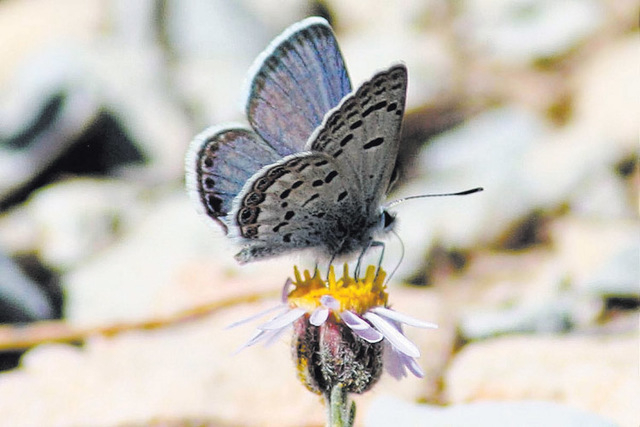Skiers, cyclists fear butterfly effect
Efforts to protect the newly endangered Mount Charleston blue butterfly could spoil plans to expand portions of Las Vegas Ski &Snowboard Resort and open its slopes to mountain bikers during the offseason.
That was the fear of about 50 resort officials and recreation enthusiasts at a meeting in Las Vegas on Tuesday night as U.S. Fish &Wildlife Service officials detailed plans to designate more than 5,500 acres as critical butterfly habitat in the Spring Mountains.
Though the designation isn’t expected to limit public access to the land, it can restrict development by requiring an additional level of review for any project proposed there.
The ski resort has submitted a 12-year plan to the U.S. Forest Service that would double the size of the operation and add six ski lifts and more snow-making equipment. The resort also wants to increase traffic during the summer with a downhill mountain biking park on a network of trails it hopes to finish by 2016, pending Forest Service approval.
Jim Seely, marketing director for the ski area 50 miles northwest of the Strip, said all of that is threatened by the current critical habitat designation, which includes most of the resort on property leased from the Forest Service.
“This is going to supersede any plans for expansion,” Seely said. “We’re looking to coexist. We just want to make sure that everyone — nature and the resort — have room to grow.”
Others were less diplomatic.
David Jaget heads up the Southern Nevada Mountain Bike Association, which has developed and helps maintain trails in the area. He said Mount Charleston only has a few trails where mountain bikes are allowed, so the prospect of a whole network of new trails is an exciting one.
He thinks it’s ridiculous that some insect most people never see could ruin all that.
“They want to restrict human activity because of a butterfly we can barely find and know little about,” Jaget said before Tuesday’s meeting. “It’s fanatical. It’s absolutely fanatical the approach they’re taking.”
The Mount Charleston blue is a distinct subspecies of the wider-ranging Shasta blue butterfly. It was added to the endangered species list in September after conservationists pushed for its protection.
The exact population is not known, but there could be fewer than 100 left in existence.
The proposed critical habitat is in three separate blocks totaling 5,561 acres at the top of Kyle and Lee canyons and along the road connecting the two, state Route 158, near Fletcher Peak — places thought to harbor the rare butterfly, its host plants and the flowers it feeds on. The ski resort is in the largest of the three areas, which also includes a stretch of state Route 156 in Lee Canyon.
The resort took to email and social media to encourage its patrons and supporters to attend Tuesday’s meeting and make their voices heard.
The Fish &Wildlife Service is accepting public input on the critical habitat proposal through Sept. 15. A link to the proposal and instructions on how to submit comments are available on the service’s Nevada website, fws.gov/nevada.
Ideally, the ski resort’s owners want to be excluded from the critical habitat. They say the listing of the butterfly is already complicating efforts to maintain or replace existing equipment, even in spots where the insect has never been documented.
But at least one researcher said such an exclusion is unlikely to happen and probably wouldn’t make much of a difference anyway.
UNLV biology professor Daniel Thompson just wrapped up a four-year study for the Forest Service and U.S. Fish &Wildlife Service on the Mount Charleston blue and other sensitive species of butterflies in the Spring Mountains.
He said the critical habitat designation is not as significant as the fact that the species was listed as endangered in the first place and is already known to occur within the ski area.
Though the decision won’t be up to him, Thompson said he thinks it is possible to expand the ski resort in a way that benefits the butterfly more than hurts it, but any such development would have to be done very carefully in just the right places.
The Fish &Wildlife Service’s Mike Senn agreed.
He said the presence of Mount Charleston blues in areas of forest cleared for ski runs suggests such work can be done in a way that improves and expands habitat.
“I would think there are ways to work around things,” said Senn, who is assistant field manager for service in Las Vegas. “Does it mean they’re going to be able to do whatever they want? No.”
A lot is still unknown about the Mount Charleston blue, which only takes flight for a month or two in the summer, with individual butterflies living no more than a week or so.
For example, Thompson said, there have been no recorded sightings of the insect in its larval stage, though his study does provide the first photographs he is aware of showing Mount Charleston blue butterfly eggs and females laying them.
The final draft of the study, which Thompson submitted to federal officials in July, documents Mount Charleston blues in areas where they hadn’t been counted since the mid-1990s, though their overall habitat remains “very restricted,” he said.
In recent weeks, Thompson and his research team recorded blues flying near and even over parts of the mountain burned in last year’s Carpenter 1 Fire, easing fears that the blaze might have wiped out a core group of the insects and destroyed prime habitat along the South Loop Trail.
“It was a big relief,” Thompson said. “It looks very likely that the burn will increase habitat over time.”
Skiers and mountain bikers will have to wait to find out whether their habitat will be allowed to grow as well.
Contact Henry Brean at hbrean@reviewjournal.com or 702-383-0350. Follow @RefriedBrean on Twitter.

















